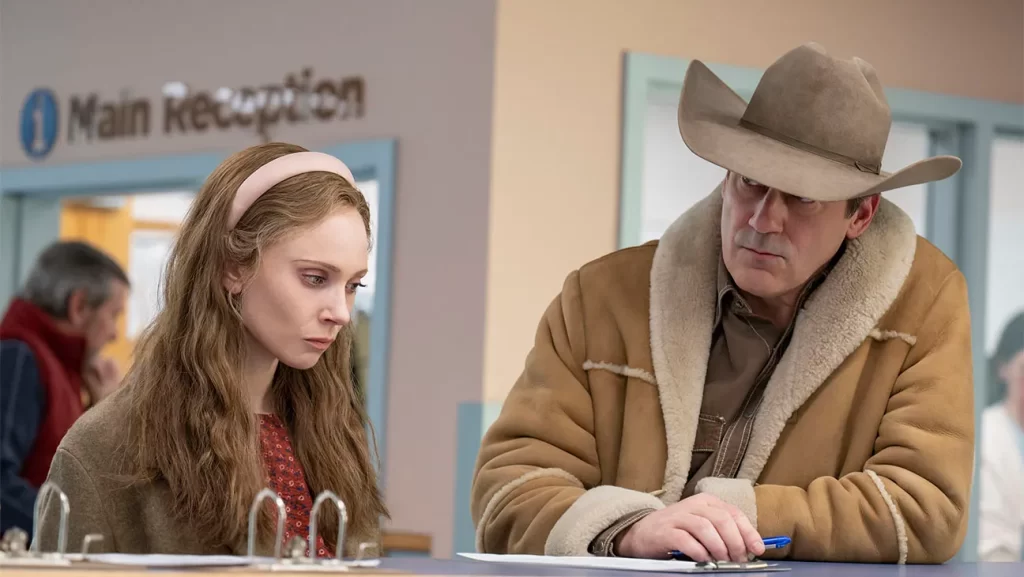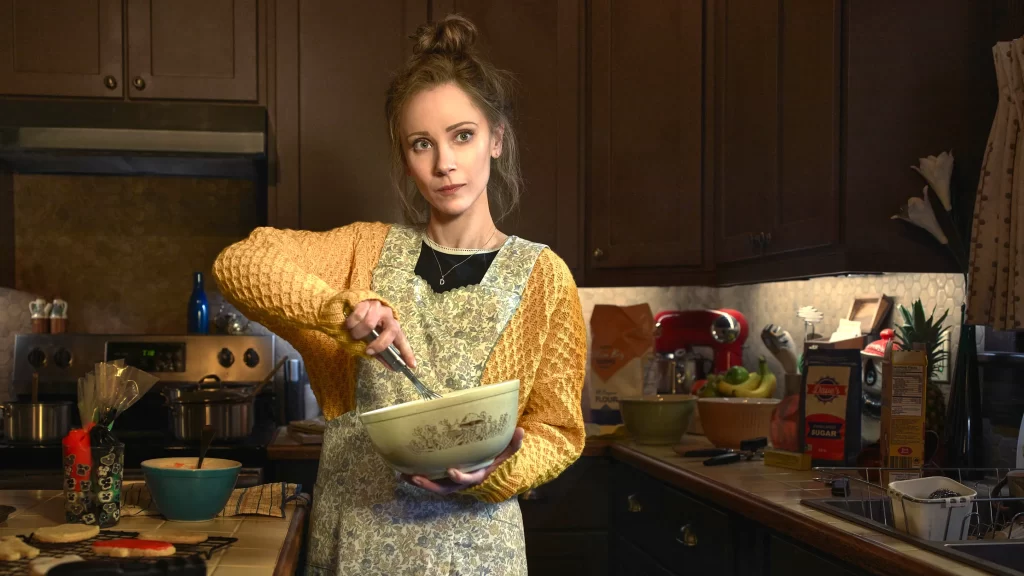With its fifth season, FX’s crime anthology Fargo makes a captivating return to the twisted roots of the Coen Brothers’ iconic 1996 film. Set in the snowy wilds of Minnesota, this latest entry retains the blend of quirky humor and shocking violence that defines the Fargo universe. But it stands apart with a riveting central performance from Juno Temple and a bold exploration of sociopolitical undercurrents pulsing through modern America.
Temple stars as Dorothy “Dot” Lyon, an outwardly cheerful suburban wife and mother hiding a ruthless survival instinct. When we first meet Dot, she’s just trying to escape a school board meeting gone haywire, only to accidentally tase a cop in the chaos. This minor arrest sets dire consequences in motion, revealing Dot’s location to her abusive ex-husband – Sheriff Roy Tillman, played with sinister charm by Jon Hamm. The sadistic Tillman, running for re-election in North Dakota on a far-right law-and-order platform, sends goons to kidnap Dot and bring her back under his control.
But in the pilot’s most gripping sequence, Dot reveals her true stripes when the home invasion begins. With improvised weapons like hairspray flamethrowers, she brutally incapacitates her attackers, kills one, and stages a daring escape. Even after fleeing to safety, however, Dot insists to the police that she was never kidnapped at all.
From this electrifying opener, Dot’s complex backstory and motives become the enigmatic backbone of the season-long mystery.
Veteran TV auteur Noah Hawley, who developed Fargo for FX, structures the plot as an intricate web of rival factions converging on Dot from all sides. Her manipulative billionaire mother-in-law Lorraine (Jennifer Jason Leigh) thinks she faked the kidnapping for money and sends a private fixer to intervene. Tillman and his gung-ho son Gator (Joe Keery) aim to drag her back across state lines, aided by a metaphysical hitman known as the sin-eater (Sam Spruell).
And investigating the whole sordid affair is Deputy Will Farr (Lamorne Morris), assisted by the very competent Officer Indira Olmstead (Richa Moorjani) – this season’s version of the stalwart Marge Gunderson from the 1996 film. Meanwhile, Dot insists through it all that nothing is wrong, desperately trying to preserve the normalcy of her current domestic life with husband Wayne (David Rysdahl) and daughter Scotty (Sienna King).
Juno Temple anchors the brewing chaos with a phenomenal performance, peeling back Dot’s layers, one enigmatic expression at a time. Dot proves to be neither a nefarious criminal nor a stereotypical victim – she’s a survivor, ruthless when cornered yet driven by compassion for her family. As her painful history with Tillman comes to light, Dot emerges as a powerful testament to feminine resilience in the face of brutal patriarchal oppression.

Around this compelling central turn, the stellar ensemble cast creates a typically off-kilter assortment of Fargo archetypes. Hamm makes Tillman a perfect encapsulation of malignant masculinity, a misogynist tyrant draped in outward folksy charm. Leigh likewise exudes Midwestern cutthroat cunning as the icy Lorraine Lyon. In the deputy roles, both Morris and Moorjani nail that signature Fargo mix of everyday warmth and steady competence. Even small supporting turns like Lukas Gage’s hapless wannabe golfer make lasting impressions.
And then there is the sinister, otherworldly presence of Spruell as the sin-eater. A mythic being cursed with immortality, he adds an uncanny aura of dread, escalating the tension as the season hurtles toward a bloody and cathartic reckoning. Hawley surrounds his strong cast with vividly unconventional camerawork, striking visuals, and surreal soundscapes, doubling down on the distinctly skewered perspective that sets Fargo apart.
This stylized aesthetic meshes perfectly with the show’s twisted take on iconic moments from the original film. Echoing the kidnapping of Jean Lundegaard, Dot’s plight highlights female empowerment, with sprinkles of gallows humor. And investigations by deputies Farr and Olmstead offer fresh riffs on Frances McDormand’s Marge, exploring the thankless diligence of ethical police in a darkening world. These loving allusions help ground the season in the Coen brothers’ seminal vision while subverting familiar beats.
At the same time, Hawley infuses the latest installment with an array of references and themes that speak directly to our current cultural moment. As the Ringer notes, “Fargo is more and more focused on contemporary politics.” Tillman’s authoritarian rhetoric, NRA fanaticism, and conspiracy mongering offer a none-too-subtle critique of the Trumpist far-right. Plots involving shady campaign funding and armed militias outside Tillman’s ranch compound the political critique.
These socio political undertones let Hawley unpack the fresh resonance of timeless Fargo motifs like “Minnesota nice” – that stereotypical regional politeness masking darker truths. Across this tense landscape, the season asks weighty questions about human nature, morality, and the malevolent forces poisoning today’s America. Are we witnessing the collapse of a once-stable society? Or exposing the decay it concealed beneath a wholesome facade all along?
Despite this borderline on-the-nose relevance, Fargo retains enough of its signature eccentricity to keep the proceedings unpredictable.
Take for example, the bizarre sequence where Dot’s history of abuse by Tillman plays out in an animated puppet show dreamscape. Or Sam Spruell’s unsettlingly supernatural sin-eater monologues. These left-field moments, described by some reviewers as Lynchian, provide palate cleansers between narrative intricacies.

They also keep the brutality from becoming overbearing – no easy task, given the rampant gore on display as tensions boil over. Limbs are severed, corpses set aflame, and heads meet unforgettably grisly ends. But just when spectacles of violence threaten to exhaust, a wry musical cue or piece of quirky Regional slang lightens the mood. The contrast highlights absurdity amid the horror.
Nowhere does this balancing act compare to the masterful season finale, which subverts expectations with surprising grace. All signs point to a bloody culminating shootout as the disparate plot threads converge and long-simmering scores await settling. And at first, the episode delivers exactly that, as Tillman’s ranch becomes a war zone between lawmen, tribalistic militias, and federal agents. Once the smoke clears, however, Fargo shifts gears into an epilogue stretching nearly half the runtime.
Instead of the usual tender denouement, we see the aftermath through wandering snippets of conversation and everyday routine. Tillman stewing in prison, deprived of his male bravado. Lorraine Lyon facing no consequences as she embraces her daughter-in-law. Life simply proceeds, which proves far more unsettling than any adrenaline-spiking carnage.
Through these structurally daring choices, Hawley creates space for resonance beyond bloody catharsis.Nowhere is that clearer than in Dot’s final confrontation with the sin-eater. He arrives at her doorstep seeking revenge, the archetypal visitor portending one last violent coup de grace. But Dot miraculously tempers his otherworldly rage and draws him into a communal supper, including hands in the biscuit dough. In this touching scene, she counsels,
“You gotta eat something made with love and joy, and be forgiven.”
Her grace overpowers his bitterness, providing hard-won hope.
Some critics contend this conclusion wraps up a bit too neatly, with the cosmic flourish of Dot’s forgiveness outpacing grounded themes. But after a season spent steeping in cynicism, her compassion stands out as profound and earned. Dot’s strength and morality enduring against forces of darkness ultimately gives Season 5 its soul.

Echoing Marge Gunderson in the starting film, Dot is neither a conventional hero nor a faultless saint. She is simply a decent person shouldering goodness amid the chaos. And her humanity shining through the gloom offers a decidedly more resonant message than any platitude. This boldly sincere ending perfectly encapsulates the duality of Fargo – violent absurdity intertwined with folksy heart.
By returning to the roots of the Coen Brothers’ treasured source material, infusing new socio political edge, and concluding with philosophical complexity, the latest Fargo stays true to tradition while feeling as fresh as its first year. Juno Temple’s mesmerizing turn cements her dramatic chops and Dot Lyon as an all-timer Fargo anti-heroine. Meanwhile, the stellar cast, haunting aesthetic, and shocking twists solidify Season 5 as a standout within the storied anthology.
For fans of the show or cult-classic film, this newest installment marks a thrilling return to form. It remixes ingredients which first made Fargo exceptional into an original tale balancing darkness with light. Through these 10 episodes, a nostalgic indictment of evil gives way to the earnest power of ordinary good. And the result stands tall in the anthology’s singular fusion of eccentricity and empathy that defines the Fargo universe.







